Google SGE (a.k.a. Search Generative Experience) is the new AI-powered search snippet announced by the search engine giant, Google, in 2023. It seeks to give generative AI responses to search queries by the users, making search all the more convenient and hassle-free.
However, this update is still in its experimental stage and undergoing several developments. It will continue to do so unless the company is certain that its users are getting the best possible experience in search.
For now, you can turn the SGE on by following the given steps:
- Open a new tab on Google
- Click on the “Labs” option at the top right corner of your page
- Sign in and choose the SGE option (turn it on)
- Follow the instructions and enjoy AI-powered responses to your queries
The SGE update is growing fast, and there’s no doubt that it will revolutionize “search” in the following days. The comprehensive summary of responses generated by AI with all the key links to further information, images, and additional FAQs, will probably answer all your queries without needing any clicks. This has posed a challenge for most business owners, who are worried about their CTR (Click-through rates) today.
There have been a few more observations that you should be aware of:
- The SGE responses (along with their “Show More” option) take up a lot of space on the SERPs, thus pushing the website with a no.1 ranking down by almost 1,562 pixels. It is about 1.5 times the height of the viewport of an average monitor.
- An average SGE content consists of nearly 10.2 links from high-authority domains.
- About 94% of links come from valuable sources BEYOND the organically-listed domains.
- Organic Wikipedia results suffer a drop of 1,507.9 pixels on the viewport, and its “People Also Ask” section goes down by 8.5 positions because of SGE responses.
- About 66% of searches are returned by a short SGE response.
- Nearly 34.1% of all searches on Google are responded to by a content-stuffed SGE response with a “Show More” button.
[Note: The stats have been taken from a study by Authoritas, an eminent digital marketing platform, regarding the impact of Google SGE on the future of SEO.]
Another Google’s AI Overview research released by SE Ranking compares SGE behavior before and post-rollout. After analyzing 100K keywords from 20 niches, SE Ranking noticed some changes in the AI-powered search. For instance:
- AIOs/SGE now appear in only 8.71% of searches, which is a significant drop from 64% observed before rollout.
- The average text length of AI-generated responses has increased to 4,342 characters from 3,485 characters previously.
- Certain niches like Relationships, Food and Beverage, and Technology are more likely to trigger AI Overviews compared to others like Healthcare, Legal, and News and Politics.
- 84.72% of AI snippets link to domains within the top 10 organic search results.
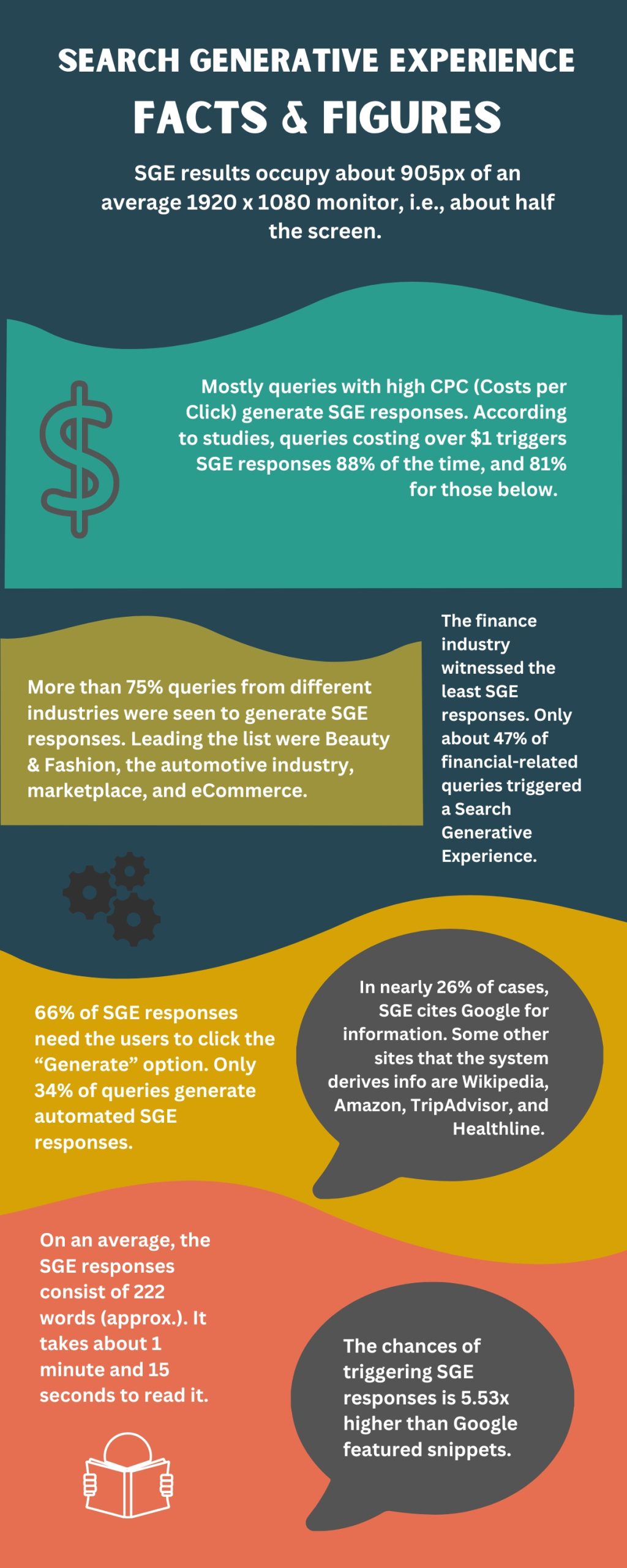
[The figures have been derived from a study published by ZipTie.dev on Google SGE]
As this is the future of Search, websites need to buckle up and pull up their socks to meet the needs of an AI-generated tomorrow. In this blog, we will give you a detailed analysis of Google SGE and tips to make the best of it. We will discuss ways to help your website hold on to its brand popularity amidst the SGE revolution.
How does a common SGE response look?
An SGE result generally consists of:
- AI-generated response to the searcher’s query
- Several links to sources for additional information
- Like/dislike buttons
- Icons linking to the search engine’s lab pages
- Follow-up questions (your suggestions or those given by Google)
Take a better look:
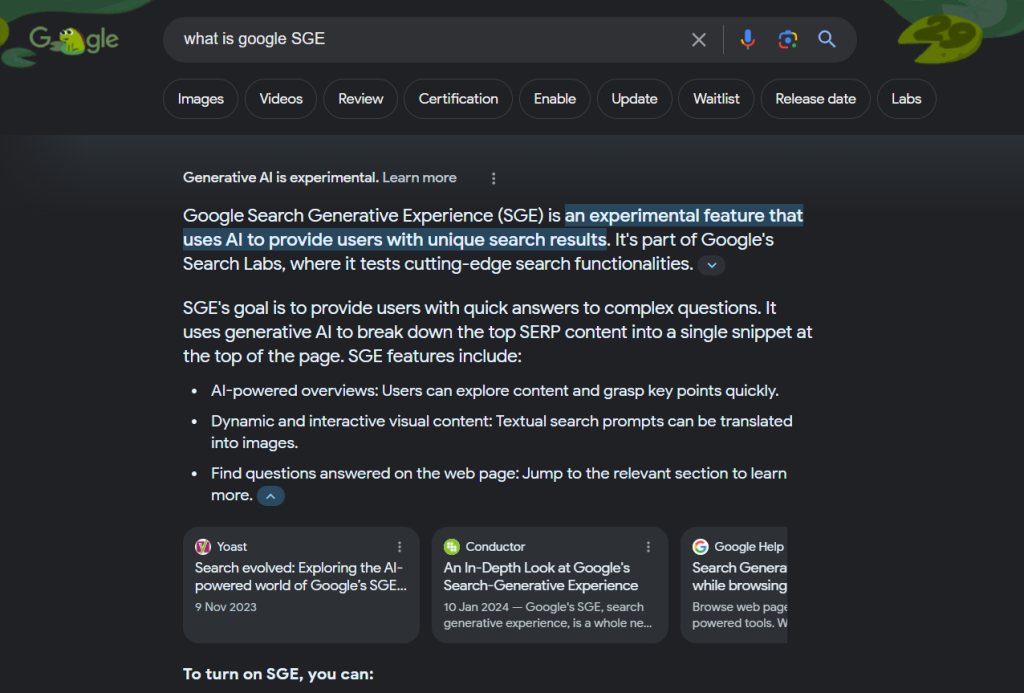
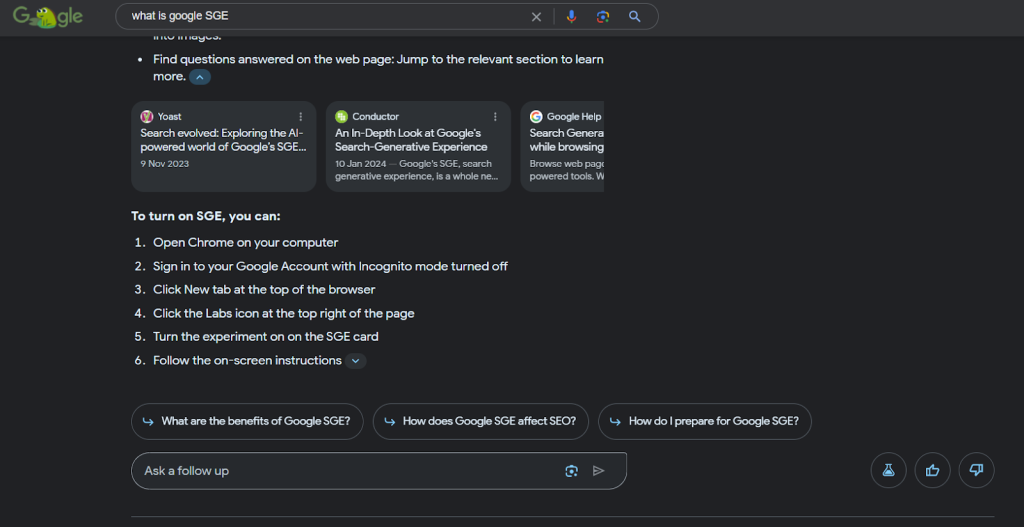
As you can see in the snapshots above, a 1-minute interaction with the AI answers all the relevant queries of the user, who is searching for a particular product or looking for some information. Hence, it jeopardizes the organic search results that include websites, which used to offer that information before.
Why should the user spend his valuable time going through the content of a bunch of websites when he can get it all in one click?
That’s exactly what Google SGE is bringing to the table.
What does Google have to say about SGE?
The company CEO, Sundar Pichai, is quite pleased with the ongoing progress in SGE. Although there is no data to suggest that it will affect organic traffic by stealing the clicks from websites, more links are added to SGE results, thereby offering more valuable information to the searchers.
Pichai also commented on the Gemini era of Google, where SGE is all set to become faster and more convenient for users. It is already witnessing a 40% reduction in latency in US English. The CEO seems to be quite pleased with the developments in the earliest stage. He says that SGE is not going anywhere anytime soon, though there is no announcement of when it will be made available outside the Search Labs.
At present, SGE is available in the US and 120+ other countries in seven languages in the Search Labs:
- English
- Hindi
- Korean
- Japanese
- Indonesian
- Spanish
- Portuguese
Once the SGE is applied in general search, users may find it easier to get longer, descriptive responses to complex queries, educational and research-specific. Topics requiring comparisons, multiple perspectives, and research will be covered conveniently in the AI-generated responses, thus enhancing “search” for all.
But what will business owners do? How will they run those affluent ads that used to bring traffic to their websites?
No worries at all!
The Senior Vice President and Chief Business Officer of Google, Philipp Schindler says that ads will continue to play a key role in the AI-generated SGE landscape. SGE is not only aiming to improve the search experience but also to give an edge to commercials and business owners leveraging the same. Currently, the search engine giant is experimenting with new formats to position the ads in the AI-powered search results. Whether those will be placed above or below the SGE responses is still unclear. But there is no doubt that ads will remain, enabling the users to connect with businesses and take necessary actions.
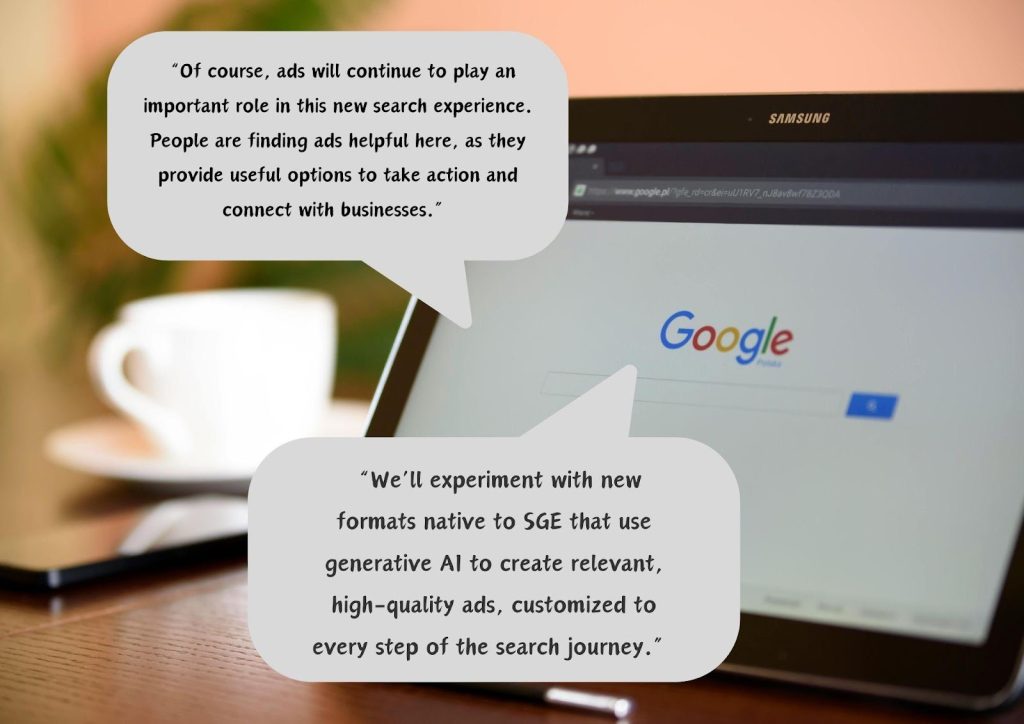
“The future is AI” – as has been said by so many people in recent days – and the search engine giant is in no delay to implement its best practices concerning the same.
Google no longer strives to provide only “answers” anymore but is planning to go beyond that and offer an exemplary, holistic experience to the searchers. Generative AI is showing positive responses for certain types of queries as of now. Pichai takes the cue and wants to go ahead with the plan to incorporate SGE in all kinds of queries pretty soon.
Is SGE a boon or bane for local businesses?
Now that you are somewhat aware of Google’s Generative AI, or Search Generative Experience (SGE), it is imperative to know how it will affect your local business.
According to the experts in the industry, if you have been employing upgraded content marketing practices so far, there is no reason to worry about this search evolution.
Already, we know that Generative AI search results may reduce the need for searchers to click through websites to a great extent. Using machine learning and natural language processing technologies, Google’s Generative AI will revolutionize search results by integrating all kinds of information at the top of SERPs.
Then how will you make your audience land on your page? If what they seek is so readily available, why will they even scroll down and click on your website?
The latest stats reveal that 91.4% of user search queries are currently triggering an SGE response. A little more than 8% of keywords failed to generate an AI response on the SERPs. The update is new, and it will undergo several tweaks, probably eliminating this gap in the future. You cannot afford to ignore this, as people (your audience) have already given AI-powered searches a major go-ahead.
AI-Assisted Searches – What People Want
According to a survey by Statista, about half of the population of US adults is totally in for AI-powered searches. The reasons are many, like unbiased results, brand recommendations, and improved ad relevance. Also, 29% of US adults prefer to make the switch to AI-generated searches, which is, quite a number considering the earlier stages.
Besides, the global AI market is currently valued at $196.63 billion, and it is set to grow more in the following days. Do you need any other reason to incorporate AI into your marketing schemes?
Optimizing Search for SGE
Before we get down to the basics of optimizing advanced search for AI-generated SGE responses, let us shed light on a few things.
All queries do not generate SGE results automatically. There are some, where you have to manually request an SGE result. Further, some queries do not generate an AI-powered SGE response at all.
Check out the following examples to understand better.
Automated SGE response:
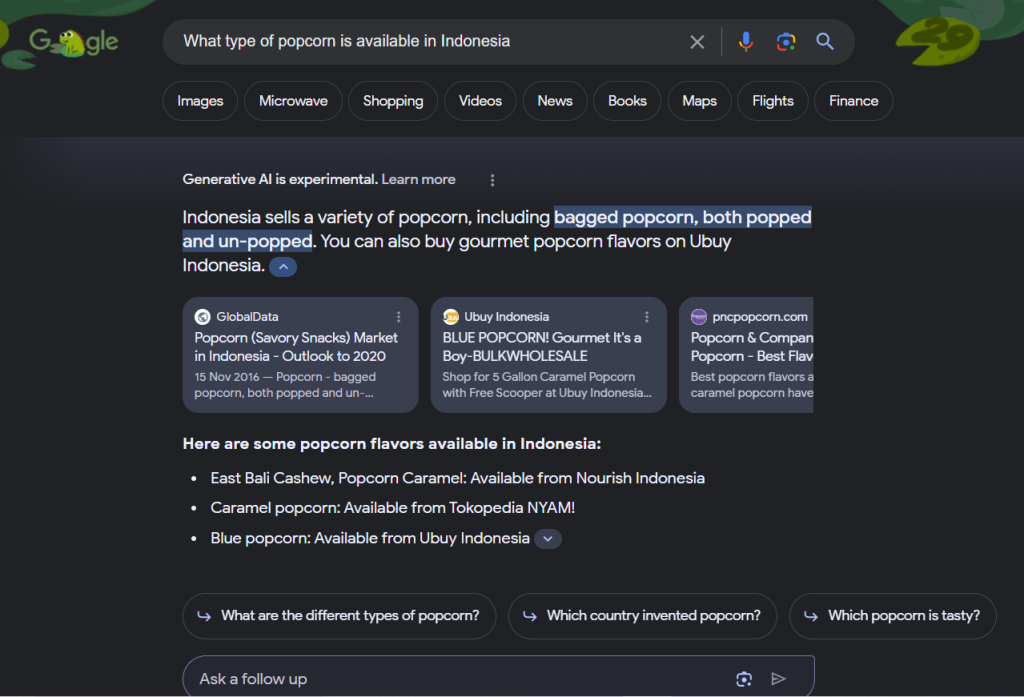
Manually-requested SGE response:
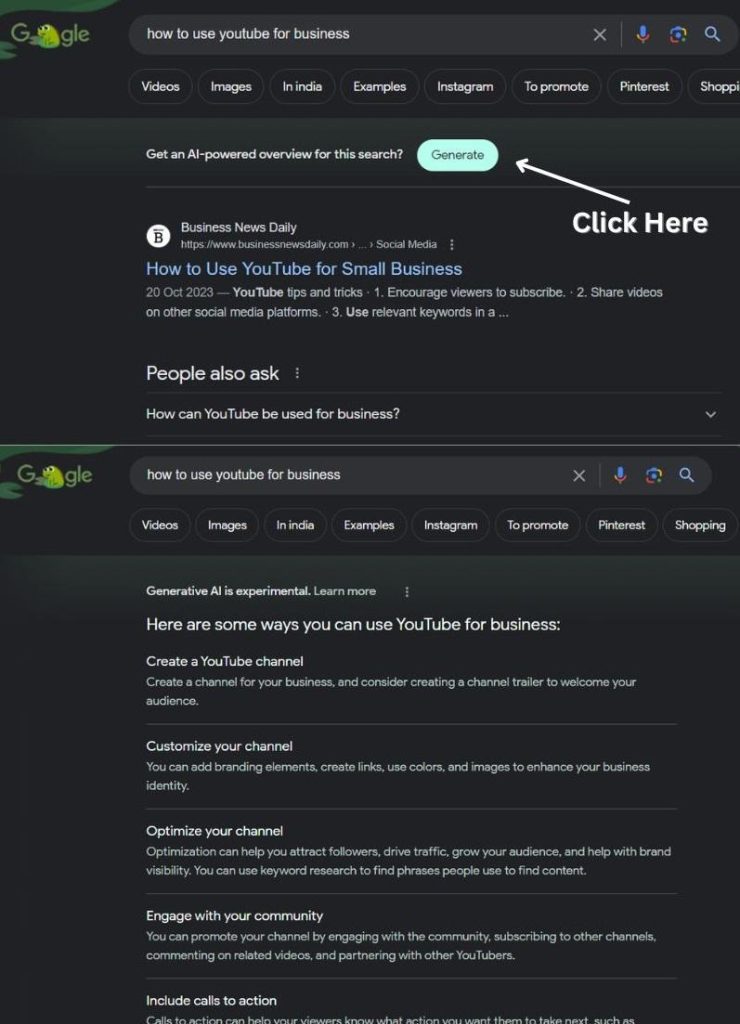
SGE response “Not Available”
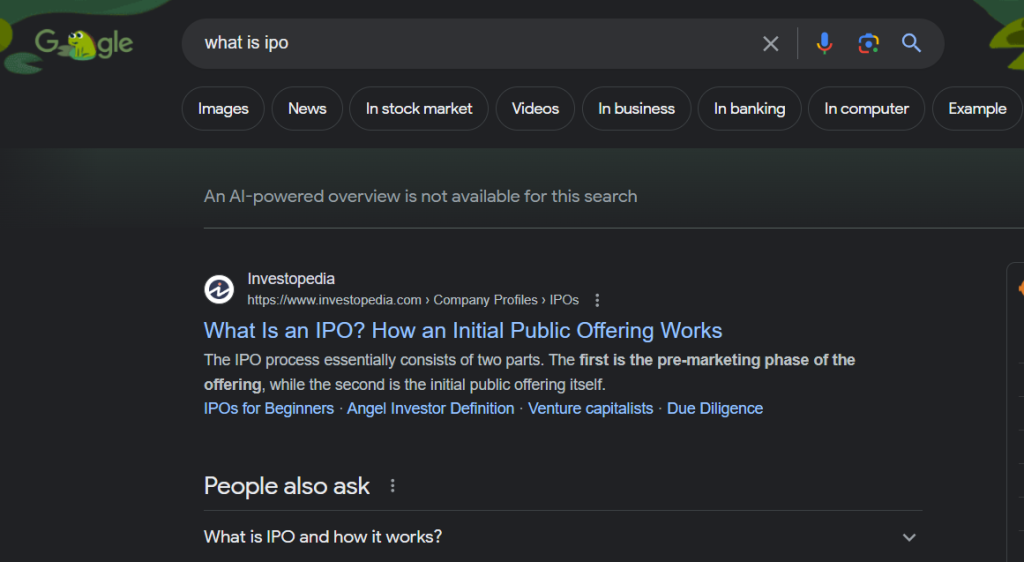
It is still quite early to start worrying about the changes that SGE will bring to organic search. However, if you are that kind of a business owner, who likes to see “opportunity” in every “change”, this is the best time to start preparing for tomorrow.
How to optimize organic search for AI-generated SGE responses
According to the latest surveys and research, SGE may cause about 30% drop in organic traffic. Moreover, AI-generated responses may appear for about 86% of search queries, posing further challenges for organic listings.
But that is not all. The latest researches also reveal that the current top-rankers may not necessarily be shown in the AI-powered SGE responses.
One more blow!
So, are all those years of efforts to rank your website on the top of SERPs going down the drain?
Unfortunately, maybe, yes!
You need to start from scratch or upgrade your marketing strategies NOW!
If your website is currently ranking at the top for relevant keywords, get ready to change all that. Further, in its current form, SGE results consist of multiple response boxes, optimizing all of which may take a toll on the SEO worker. If at all, it is possible to optimize the content for one or a few of the SGE boxes. You should also note that the content for each industry and niche market varies widely on the SGE responses. While optimizing, it is essential to keep these basic things in mind.
However, we do not know yet what the final version of Google SGE will be like. For now, we can just adapt and improvise our SEO strategies based on the existing data. The following suggestions may help:
Not relying on keyword research entirely
To date, you have been optimizing your content based on relevant key phrases that searchers use to look for products/services on Google. Well, that needs to change. As zero-click updates keep growing, keywords are holding lesser value with each passing day. Using Google’s “People Also Ask” feature is the new approach to creating content around relevant queries. Despite their zero-search volume in some tools, these are mostly accurate in revealing what most people are currently searching for. Audience research and creating content based on real-time data from surveys and research is another way to prepare for the zero-click future.
Focusing on brand reputation across the web
Every time your brand name is reflected on the SGE results, know it will include third-party mentions besides your website’s content. The snippet will generally consist of information about your business, its reputation as reflected on other sources, and details of products/services, including reviews. The AI search model will include all the information deemed necessary to give a holistic idea about your business to the searcher. Hence, you must protect and maintain the reputation of your brand online. Here’s how to do it:
- Optimize brand-specific content on your website, e.g. the About Us page.
- Ask your “happy and loyal” customers to leave reviews on your website (or social media page)
- Communicate relevant information about your business through structured data (schema markup)
- Review all backlinks on your website to keep track of third-party mentions
Prioritizing long-tail, detailed search queries
Once SGE gets rolled out in its glorious form, all top-of-the-funnel queries will more likely be answered by its AI-generated content. However, it’s the middle and bottom funnel content that will still follow the traditional organic method of visibility. It is best, hence, to curate your content around the same to get more organic traffic, and leads that depict higher chances of conversion.
Let us show you an example. Take the keyword, “What are some things to do in LA” and check out the generative AI content on Google.
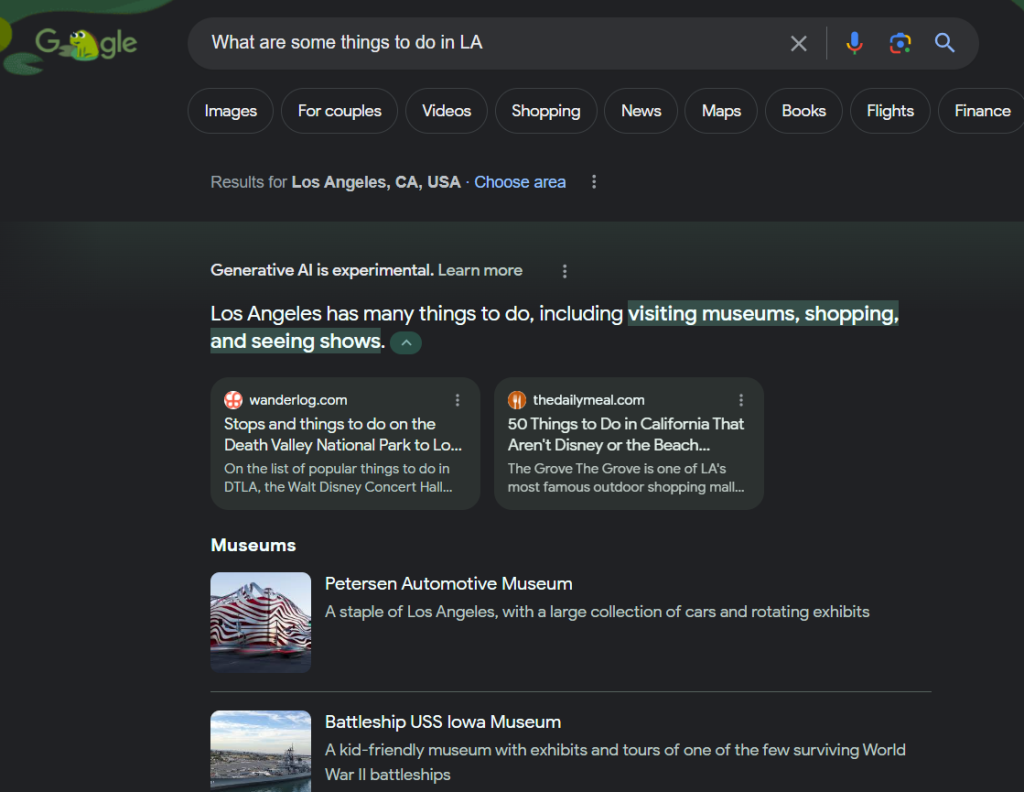
Now, let’s tweak this keyword and make it a long-tail, more specific one – What are some affordable things to do in LA with kids under 10?
See the result:

As you can see, Google SGE, in its current form, fails to give an AI-generated response to the long-tail, detailed queries. Targeting these search queries in your content increases its chances of ranking at the top of SERPs.
Focusing on “Real” SEO metrics, i.e. revenue
Vanity metrics, like clicks and impressions, are soon going to be obsolete with the gradual progress of Google Search Generative Experience. There is also a big doubt if the Google Search Console will be able to read such KPIs correctly in the future. You need to start focusing on real metrics, like revenue, to keep the game on. SEO experts will help generate reports based on real metrics, like the number of signups or sales so that you get a concrete idea of “results” in the zero-click world.
How eCommerce sites can optimize SGE for greater revenue
It is time to prioritize your product pages, and not the category pages, to generate SGE responses for relevant queries. These will get featured directly in the search results under SGE AI.
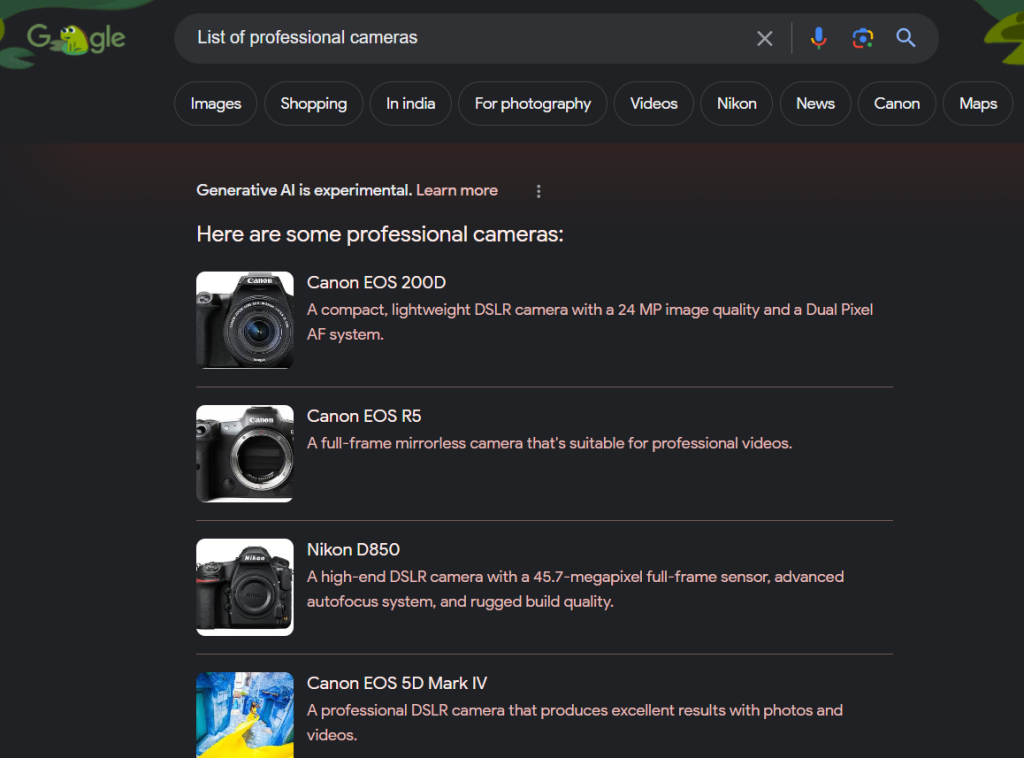
By optimizing your product pages with descriptive, informative content, you will increase your chances of getting featured in the SGE. Use short, crisp content to underline key features of your product before going down to detailed descriptions.
In the descriptions, make sure you add:
- Buying guides, usage instructions, product comparisons, etc.
- Schema markup, like pricing, rankings, reviews, etc.
- Comprehensive product specifications
- Reviews and user feedback
A holistic product description will have a higher chance of being featured in the SGE results. Make sure you follow the given hacks to set your eCommerce website apart.
Apart from these strategies, you also need to keep two things in mind:
- Topical authority (Following the E.E.A.T. principle)
- Enhanced linking

Content is Important STILL – Context is The New Queen
There’s no denying that content continues to be an integral part of digital marketing, even in the world of Generative AI. However, context now holds equal or almost equal importance. While creating any kind of content for your website, whether it is a blog post, press release, online guide, newsletter, or promotional ad, do not forget the context of the same. Only then you will increase the chances of capturing the attention of Google’s generative AI tech.
If you want your content to be featured in Google’s SGE (which is the crucial point of this blog), make sure it speaks to the users’ needs directly. As shown above, the generative AI responses feature links to the sources of the information. Your website can be on the list if it fulfills the set of requirements.
Let’s help you understand with the following example:
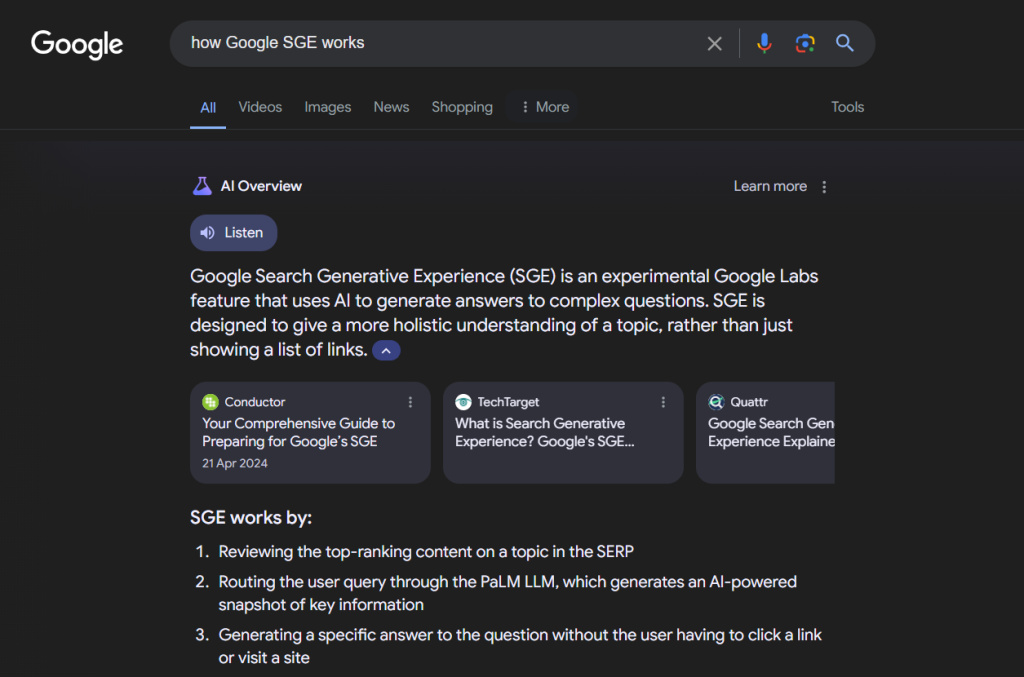
As you can see, the given keyword, “How Google SGE works”, generates an AI response that features a few carefully-articulated blogs that top its list of informational sources.
If your content exudes a comprehensive tone packed with relevant data to support your suggestions and provide the users with a holistic overview of the topic, your website can make it on this list.
The key is to ponder on probable questions that users may have and answer those queries directly. Also, provide substantial evidence to support your claims or suggestions, i.e. use real-time data.
When you understand the context of search queries and resolve the same through your content, the chances of getting featured increase.
FAQs on Google SGE
Why does Google SGE matter so much?
The Search Generative Experience started by Google matters because it revolutionizes the entire search practice. Previously, websites used to leverage keywords or search queries to get to the top of SERPs. With Google’s generative AI on the field, that becomes a tad difficult. As most users will be fed all kinds of information generated through AI technologies, they will probably not feel the need to click on content that these businesses produce.
Do I need to be worried about Google SGE?
AI-powered searches on Google are something to consider, but there’s no reason to worry as of now. If you have been upgrading your marketing strategies according to the latest trends, you are in a good spot. After all, the responses generated by SGE will be taken from various sources of content, and your website can be one of those. All you have to do is understand user intent and develop your content accordingly.
Why should digital marketers be aware of Google SGE?
SGE will reduce the dependency on blue links, i.e. individual posts that businesses generate. Hence, digital marketers should shift their focus to AI-powered results, and how information is perceived by the AI tech. It will help improve discoverability in both conventional searches and generative AI responses. Optimizing content on user intent, quality of information, and topical depth will serve the purpose. The marketers should also ensure that the brand they are promoting must have a robust digital presence across multiple well-to-do channels.
Does that mean Google ads will no longer hold significance in the future?
No! There has been nothing so far to diminish the importance of Google ads. According to Philipp Schindler, the Chief Business Officer at Google, ads will be revolutionized with SGE to offer a holistic overview to the users, as well as a commercial edge to the brands promoting their services/products on the search engine. The company is currently working on that. Hence, there is no reason to believe that ads will be obsolete in the future.
How do I keep my position intact in the SERPs despite SGE responses?
Your brand needs to step up its content marketing and social media marketing strategies, and not to forget maintain consistent brand information across all channels. You should take great care while optimizing your content, improving UX on your website, and monitoring reviews to get features in the AI-powered results. Hiring a professional to revamp your marketing strategies can be a good place to start.
How SGE will change the traditional search scenario?
Google SGE will prioritize solutions over links, thus partially causing “clicks” to lose their importance. As SGE is AI-generated, it will use multiple sources to create generative content that answers all of the users’ queries on a particular topic. When a searcher types in his query into the search box of Google, the SGE content will strive to provide answers directly, instead of bombarding with a series of clickable links.
Can website owners optimize their content for SGE?
Of course, they can! One needs to understand how SGE works, what links they feature, and how they derive content from different sources for a definite search query first. If your website’s content prioritizes user queries and aims to resolve the same, the chances are high that it will be featured in the SGE responses. Follow the E.E.A.T. principle and create content that is both informative and authoritative.
What is the difference between Google SGE and featured snippets?
Interestingly, everyone is wondering the same right now, and rightly so. As SGE is still in its experimental phase, several users are mistaking it for a “featured snippet” that is already shown in Google search results. However, SGE on Google is widely different from featured snippets.
In featured snippets, you get a fragment of content directly from one website. In the AI-generated SGE responses, you are likely to get comprehensive content from multiple sources (right now from at least two) along with follow-up questions, product catalogs (wherever necessary), like/dislike buttons, and links to additional resources.
In its current form, you can say that the Google SGE is an advanced form of Google featured snippet.
Are the SGE results cached?
Although there is no evidence to suggest the same, it is believed that some of the popular responses are indeed cached. It will be a long time before Google generates unique AI responses for millions of different search queries.
Is the future of all searches AI?
According to the officials, Google’s future is AI-powered for certain. Although the Google SGE is far from being the supreme AI-powered response tool, for now, it is surely upgrading. If the rumors are to be believed, the search engine giant will improve the SGE to deliver user-specific search results in the future.
Will SGE make organic searches go extinct?
Not really! The Google SGE will streamline responses to search queries, true, but it will not hamper organic traffic to websites, if the latter optimizes their content for the AI-generated responses. By crafting authoritative content, maintaining a positive brand reputation, and leveraging link-building, website owners can increase their chances of being featured, thus maintaining their hold in the SERPs.
Final Words
Google’s SGE or Search Generative Experience is all set to transform the way individuals seek and access information, significantly impacting organic searches worldwide. With a shift in focus to information instead of links, the SGE update has brought a frown on the face of most website owners. Till now they were enjoying top ranks on the SERPs by optimizing their content for relevant search queries (keywords). The SGE update is planning to change all that pretty soon. As zero-click searches grow in number, websites will tend to lose a chunk of organic traffic if they continue with traditional marketing tactics.
However, business owners who can see this as an opportunity to stand out have something for a surprise. They can optimize their content for the AI-powered SGE by working on the E.E.A.T. (Expertise, Experience, Authoritativeness, and Trustworthiness) principle, guaranteeing topical authority. Further, they can improve their link-building strategies to get featured in the SGE responses.
E-commerce sites need to prioritize product pages more now, as those may get featured as a catalog in the SGE responses. In other words, if you are ready to upgrade and change your ways, there is nothing to worry about the AI-generated responses to searchers’ queries.
Organic traffic is still very much yours to claim!
